Giant Elastocaloric Effect and Improved Cyclic Stability in a Directionally Solidified (Ni50Mn31Ti19)99B1 Alloy
Abstract
:1. Introduction
2. Materials and Methods
3. Results
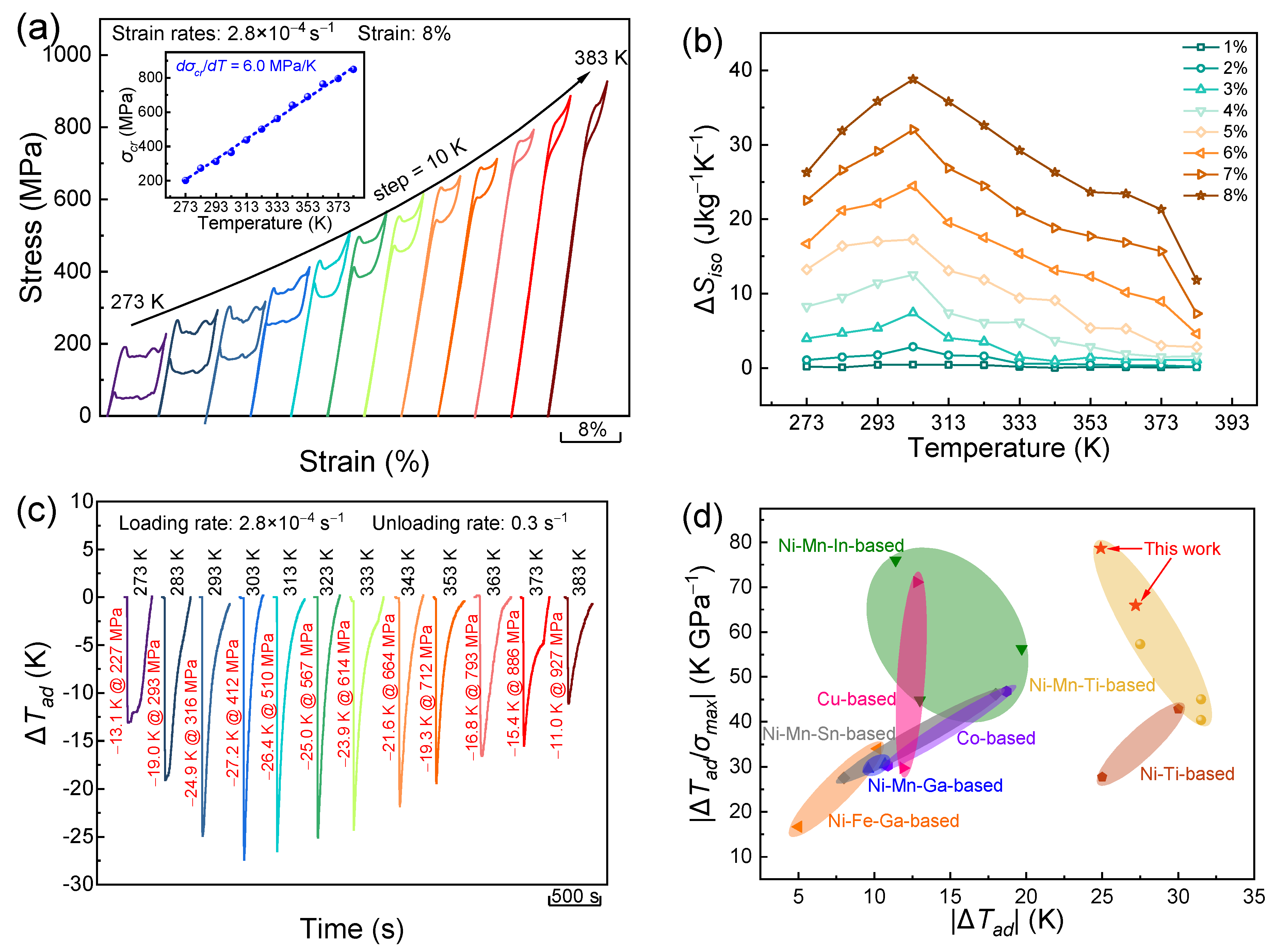
4. Conclusions
Supplementary Materials
Author Contributions
Funding
Institutional Review Board Statement
Informed Consent Statement
Data Availability Statement
Conflicts of Interest
References
- Lloveras, P.; Stern-Taulats, E.; Barrio, M.; Tamarit, J.L.; Crossley, S.; Li, W.; Pomjakushin, V.; Planes, A.; Mañosa, L.; Mathur, N.D.; et al. Giant barocaloric effects at low pressure in ferrielectric ammonium sulphate. Nat. Commun. 2015, 6, 8801. [Google Scholar] [CrossRef] [PubMed]
- Mañosa, L.; Planes, A.; Acet, M. Advanced materials for solid-state refrigeration. J. Mater. Chem. A 2013, 1, 4925–4936. [Google Scholar] [CrossRef]
- Tušek, J.; Engelbrecht, K.; Millán-Solsona, R.; Mañosa, L.; Vives, E.; Mikkelsen, L.P.; Pryds, N. The elastocaloric effect: A way to cool efficiently. Adv. Energy Mater. 2015, 5, 1500361. [Google Scholar] [CrossRef]
- Mañosa, L.; Planes, A. Materials with giant mechanocaloric effects: Cooling by strength. Adv. Mater. 2017, 29, 1603607. [Google Scholar] [CrossRef]
- Yang, J.; Wang, H.; Li, Z.; Zou, N.; Yan, H.; Yang, B.; Zuo, L. Crystallography of stress-induced martensitic transformation and giant elastocaloric effect in a <001>A textured Ni27Cu21Mn46Sn6 shape memory alloy. Acta Mater. 2024, 263, 119546. [Google Scholar]
- Heczko, O.; Cejpek, P.; Drahokoupil, J.; Holý, V. Structure and microstructure of Ni-Mn-Ga single crystal exhibiting magnetic shape memory effect analysed by high resolution X-ray diffraction. Acta Mater. 2016, 115, 250–258. [Google Scholar] [CrossRef]
- Heczko, O.; Kopeček, J.; Straka, L.; Seiner, H. Differently mobile twin boundaries and magnetic shape memory effect in 10M martensite of Ni–Mn–Ga. Mater. Res. Bull. 2013, 48, 5105–5109. [Google Scholar] [CrossRef]
- Liu, J.; Gottschall, T.; Skokov, K.P.; Moore, J.D.; Gutfleisch, O. Giant magnetocaloric effect driven by structural transitions. Nat. Mater. 2012, 11, 620–626. [Google Scholar] [CrossRef]
- Gottschall, T.; Skokov, K.P.; Frincu, B.; Gutfleisch, O. Large reversible magnetocaloric effect in Ni-Mn-In-Co. Appl. Phys. Lett. 2015, 106, 118694. [Google Scholar] [CrossRef]
- Zhang, G.Y.; Li, Z.B.; Yang, J.J.; Yang, B.; Wang, D.H.; Zhang, Y.D.; Esling, C.; Hou, L.; Li, X.; Zhao, X.; et al. Giant elastocaloric effect in a Mn-rich Ni44Mn46Sn10 directionally solidified alloy. Appl. Phys. Lett. 2020, 116, 023902. [Google Scholar] [CrossRef]
- Wang, H.; Li, D.; Zhang, G.; Li, Z.; Yang, B.; Yan, H.; Cong, D.; Esling, C.; Zhao, X.; Zuo, L. Highly sensitive elastocaloric response in a directionally solidified Ni50Mn33In15.5Cu1.5 alloy with strong <001>A preferred orientation. Intermetallics 2022, 140, 107379. [Google Scholar]
- Wei, L.; Zhang, X.; Liu, J.; Geng, L. Orientation dependent cyclic stability of the elastocaloric effect in textured Ni-Mn-Ga alloys. AIP Adv. 2018, 8, 055312. [Google Scholar] [CrossRef]
- Yang, Z.; Cong, D.Y.; Sun, X.M.; Nie, Z.H.; Wang, Y.D. Enhanced cyclability of elastocaloric effect in boron-microalloyed Ni-Mn-In magnetic shape memory alloys. Acta Mater. 2017, 127, 33–42. [Google Scholar] [CrossRef]
- Yan, H.L.; Wang, L.D.; Liu, H.X.; Huang, X.M.; Jia, N.; Li, Z.B.; Yang, B.; Zhang, Y.D.; Esling, C.; Zhao, X.; et al. Giant elastocaloric effect and exceptional mechanical properties in an all-d-metal Ni–Mn–Ti alloy: Experimental and ab-initio studies. Mater. Des. 2019, 184, 108180. [Google Scholar] [CrossRef]
- Cong, D.Y.; Xiong, W.X.; Planes, A.; Ren, Y.; Manosa, L.; Cao, P.Y.; Nie, Z.H.; Sun, X.M.; Yang, Z.; Hong, X.F.; et al. Colossal elastocaloric effect in ferroelastic Ni-Mn-Ti alloys. Phys. Rev. Lett. 2019, 122, 255703. [Google Scholar] [CrossRef] [PubMed]
- Li, Y.; Sun, W.; Zhao, D.; Xu, H.; Liu, J. An 8 K elastocaloric temperature change induced by 1.3% transformation strain in Ni44Mn45−xSn11Cux alloys. Scr. Mater. 2017, 130, 278–282. [Google Scholar] [CrossRef]
- Ma, G.; Li, C.; Chen, M.; Zong, S.; Zhang, Y.; Zhao, S.; Chen, F.; Xuan, H. Elastocaloric effect and magnetic properties of Ni50Mn31.5Ti18Cu0.5 shape memory alloy. J. Supercond. Novel Magn. 2022, 35, 1669–1676. [Google Scholar] [CrossRef]
- Fornell, J.; Tuncer, N.; Schuh, C.A. Orientation dependence in superelastic Cu-Al-Mn-Ni micropillars. J. Alloys Compd. 2017, 693, 1205–1213. [Google Scholar] [CrossRef]
- Villa, F.; Villa, E.; Righi, L.; Ruggieri, P.; Bennato, N.; Battiston, S.; Passaretti, F.; Casati, R. Effect of the thermal processing on the microstructural, functional and mechanical properties of cast polycrystalline NiMnTi alloys. J. Alloys Compd. 2024, 1000, 175099. [Google Scholar] [CrossRef]
- Xiao, F.; Jin, M.J.; Liu, J.; Jin, X.J. Elastocaloric effect in Ni50Fe19Ga27Co4 single crystals. Acta Mater. 2015, 96, 292–300. [Google Scholar] [CrossRef]
- Fazeli, S.; Izadifar, M.; Dolado, J.S.; Ramazani, A.; Sadrnezhaad, S.K. Atomistic study of the effect of crystallographic orientation on the twinning and detwinning behavior of NiTi shape memory alloys. Comput. Mater. Sci. 2022, 203, 111080. [Google Scholar] [CrossRef]
- Hsu, Y.T.; Wu, C.T.; Chen, C.H. Nanoscale-precipitate-strengthened (Ni,Cu)-rich TiNiCu shape memory alloy with stable superelasticity and elastocaloric performance. J. Alloys Compd. 2024, 997, 174937. [Google Scholar] [CrossRef]
- Meng, J.; Xie, L.; Yu, Q.; Wang, J.; Jiang, C. Toughening the grain boundaries by introducing a small amount of the second phase: Ni-Cu-Mn-Ga shape memory alloys as an example. Acta Mater. 2024, 263, 119469. [Google Scholar] [CrossRef]
- Guan, Z.; Bai, J.; Zhang, Y.; Sun, S.; Gu, J.; Liang, X.; Zhang, Y.; Esling, C.; Zhao, X.; Zuo, L. Achieved good mechanical properties and large elastocaloric effect in Ni-Mn-Ti-Cu-B alloy: Experiments and first-principles calculations. J. Alloys Compd. 2023, 930, 167477. [Google Scholar] [CrossRef]
- Zhang, Y.; Yang, S.; Wang, L.; Pan, S.; Zhang, J.; Liu, X.; Wang, C. Development of boron-microalloyed Co–V–Al–Fe shape memory alloys. Intermetallics 2023, 157, 107889. [Google Scholar] [CrossRef]
- Li, X.; Fautrelle, Y.; Gagnoud, A.; Du, D.; Wang, J.; Ren, Z.; Nguyen-Thi, H.; Mangelinck-Noel, N. Effect of a weak transverse magnetic field on solidification structure during directional solidification. Acta Mater. 2014, 64, 367–381. [Google Scholar] [CrossRef]
- Li, B.; Li, S.M.; Yang, B.; Zhong, H.; Liu, Z.P.; Li, D. Enhancing the elastocaloric effect and thermal cycling stability in dendritic-like Ni50Mn31.6Ti18.4 single crystal. J. Alloys Compd. 2023, 936, 168310. [Google Scholar] [CrossRef]
- Xu, F.; Zhu, C.; Wang, J.; Luo, F.; Zhu, X.; Xu, J.; Chen, S.; Wang, J.; Ma, G.; Chen, F.; et al. Enhanced elastocaloric effect and mechanical properties of Gd-doped Ni-Co-Mn-Ti-Gd metamagnetic shape memory alloys. J. Alloys Compd. 2023, 960, 170768. [Google Scholar] [CrossRef]
- Li, B.; Zheng, L.J.; Zhang, H. Microstructure-property relationship in Zr-alloyed Ni-rich NiTi alloys: Enhancements in high-temperature stability and superelasticity. Mater. Charact. 2024, 208, 113649. [Google Scholar] [CrossRef]
- Zhao, Y.; Hou, L.; Li, X.; Su, H.; Zhang, J. On the formation of gradient-distributed dendrites in a single crystal nickel-based superalloy directionally solidified under transverse static magnetic field. Mater. Charact. 2024, 207, 113508. [Google Scholar] [CrossRef]
- Niu, Y.; Chen, H.; Zhang, X.; Li, S.; Cong, D.; Ma, T.; Li, S.; Lin, J.; Wang, Y.D. Achieving excellent superelasticity and extraordinary elastocaloric effect in a directionally solidified Co-V-Ga alloy. Scr. Mater. 2021, 204, 114123. [Google Scholar] [CrossRef]
- Zhao, Y.; Ming, F.; Jia, N.; Chen, J.; Ren, S.; Xu, W.; Qu, X. High-strength superelastic as-cast Ni50.9Ti49.1-TiB2 in-situ composites. Mater. Sci. Eng. A 2021, 818, 141451. [Google Scholar] [CrossRef]
- Pfeuffer, L.; Lemke, J.; Shayanfar, N.; Riegg, S.; Koch, D.; Taubel, A.; Scheibel, F.; Kani, N.A.; Adabifiroozjaei, E.; Molina-Luna, L.; et al. Microstructure engineering of metamagnetic Ni-Mn-based Heusler compounds by Fe-doping: A roadmap towards excellent cyclic stability combined with large elastocaloric and magnetocaloric effects. Acta Mater. 2021, 221, 117390. [Google Scholar] [CrossRef]
- Zhang, X.; Chen, H.; Li, S.; Niu, Y.; Yin, T.; Song, C.; Lang, R.; Cong, D.; Li, S.; Wang, Y.D. Enhanced cyclability of superelasticity and elastocaloric effect in Cu and B co-doped Co-Ni-Ga shape memory alloys. J. Alloys Compd. 2022, 918, 165633. [Google Scholar] [CrossRef]
- Zhang, X.; Zhang, M.; Cui, T.; Li, J.; Liu, Q.; Wang, H. The enhancement of the mechanical properties and the shape memory effect for the Cu-13.0Al-4.0Ni alloy by boron addition. J. Alloys Compd. 2019, 776, 326–333. [Google Scholar] [CrossRef]
- Li, X.W.; Yang, M.H.; Sun, C.H.; Ruan, Y.; Wei, B. Enhanced tensile performance of ternary Fe-Ni-Ti peri-eutectic alloy through directional solidification associated with thermal processing. Mater. Lett. 2024, 369, 136743. [Google Scholar] [CrossRef]
- Qian, S.X.; Ling, J.Z.; Hwang, Y.; Radermacher, R.; Takeuchi, I. Thermodynamics cycle analysis and numerical modeling of thermoelastic cooling systems. Int. J. Refrig. 2015, 56, 65–80. [Google Scholar] [CrossRef]
- Moya, X.; Defay, E.; Heine, V.; Mathur, N.D. Too cool to work. Nat. Phys. 2015, 11, 202–205. [Google Scholar] [CrossRef]
- Zhang, G.; Wang, H.; Li, Z.; Yang, B.; Yan, H.; Zuo, L. Giant elastocaloric effect covering a wide temperature region in a directionally solidified Ni50Mn30Ti20 alloy. Scr. Mater. 2023, 237, 115725. [Google Scholar] [CrossRef]
- Li, D.; Li, Z.; Yang, J.; Li, Z.; Yang, B.; Yan, H.; Wang, D.; Hou, L.; Li, X.; Zhang, Y.; et al. Large elastocaloric effect driven by stress-induced two-step structural transformation in a directionally solidified Ni55Mn18Ga27 alloy. Scr. Mater. 2019, 163, 116–120. [Google Scholar] [CrossRef]
- Zhao, D.; Castán, T.; Planes, A.; Li, Z.; Sun, W.; Liu, J. Enhanced caloric effect induced by magnetoelastic coupling in NiMnGaCu Heusler alloys: Experimental study and theoretical analysis. Phys. Rev. B 2017, 96, 224105. [Google Scholar] [CrossRef]
- Huang, X.M.; Zhao, Y.; Yan, H.L.; Tang, S.; Yang, Y.; Jia, N.; Yang, B.; Li, Z.; Zhang, Y.; Esling, C.; et al. A first-principle assisted framework for designing high elastocaloric Ni–Mn-based magnetic shape memory alloy. J. Mater. Sci. Technol. 2023, 134, 151–162. [Google Scholar] [CrossRef]
- Sun, W.; Liu, J.; Zhao, D.; Zhang, M. Directional solidification and elastocaloric effect in a Ni45Mn44Sn11 magnetic shape memory alloy. J. Phys. D Appl. Phys. 2017, 50, 444001. [Google Scholar] [CrossRef]
- Li, Z.; Li, Z.; Yang, J.; Li, D.; Yang, B.; Yan, H.; Nie, Z.; Hou, L.; Li, X.; Zhang, Y.; et al. Large elastocaloric effect in a polycrystalline Ni45.7Co4.2Mn37.3Sb12.8 alloy with low transformation strain. Scr. Mater. 2019, 162, 486–491. [Google Scholar] [CrossRef]
- Wang, Y.; Liu, C.; Wang, H.; Li, Z.; Li, J.; Yang, B.; Yan, H.; Zuo, L. Orientation dependence of elastocaloric effect in a Cu71.3Al17.5Mn11.2 single crystal. J. Alloys Compd. 2023, 969, 172392. [Google Scholar] [CrossRef]
- Wu, Y.; Ertekin, E.; Sehitoglu, H. Elastocaloric cooling capacity of shape memory alloys—Role of deformation temperatures, mechanical cycling, stress hysteresis and inhomogeneity of transformation. Acta Mater. 2017, 135, 158–176. [Google Scholar] [CrossRef]
- Tušek, J.; Engelbrecht, K.; Mikkelsen, L.P.; Pryds, N. Elastocaloric effect of Ni-Ti wire for application in a cooling device. J. Appl. Phys. 2015, 117, 124901. [Google Scholar] [CrossRef]
- Qian, S.X.; Geng, Y.L.; Wang, Y.; Muehlbauer, J.; Ling, J.Z.; Hwang, Y.; Radermacher, R.; Takeuchi, I. Design of a hydraulically driven compressive elastocaloric cooling system. Sci. Technol. Built Environ. 2016, 22, 500–506. [Google Scholar] [CrossRef]
- Wang, J.; Yu, Q.; Xu, K.; Zhang, C.; Wu, Y.; Jiang, C. Large room-temperature elastocaloric effect of Ni57Mn18Ga21In4 alloy undergoing a magnetostructural coupling transition. Scr. Mater. 2017, 130, 148–151. [Google Scholar]
- Masdeu, F.; Pons, J.; Torrens-Serra, J.; Chumlyakov, Y.; Cesari, E. Superelastic behavior and elastocaloric effect in a Ni51.5Fe21.5Ga27.0 ferromagnetic shape memory single crystal under compression. Mater. Sci. Eng. A 2022, 833, 142362. [Google Scholar] [CrossRef]
- Li, Z.Z.; Li, Z.B.; Li, D.; Yang, J.J.; Yang, B.; Hu, Y.; Wang, D.H.; Zhang, Y.D.; Esling, C.; Zhao, X.; et al. Achieving a broad refrigeration temperature region through the combination of successive caloric effects in a multiferroic Ni50Mn35In15 alloy. Acta Mater. 2020, 192, 52–59. [Google Scholar] [CrossRef]
- Zhao, D.W.; Liu, J.; Chen, X.; Sun, W.; Li, Y.; Zhang, M.X.; Shao, Y.Y.; Zhang, H.; Yan, A. Giant caloric effect of low-hysteresis metamagnetic shape memory alloys with exceptional cyclic functionality. Acta Mater. 2017, 133, 217–223. [Google Scholar] [CrossRef]
- Yuan, B.; Zhong, S.; Qian, M.; Zhang, X.; Geng, L. Elastocaloric effect in bamboo-grained Cu71.1Al17.2Mn11.7 microwires. J. Alloys Compd. 2021, 850, 156612. [Google Scholar] [CrossRef]
- Xu, S.; Huang, H.; Xie, J.; Takekawa, S.; Xu, X.; Omori, T.; Kainuma, R. Giant elastocaloric effect covering wide temperature range in columnar-grained Cu71.5Al17.5Mn11 shape memory alloy. APL Mater. 2016, 4, 106106. [Google Scholar] [CrossRef]
- Liu, C.; Li, Z.B.; Wang, H.L.; Wang, Y.P.; Yang, B.; Yan, H.L.; Cong, D.Y.; Zhao, X.; Zuo, L. Long-term stable elastocaloric effect in a Heusler-type Co51V33Ga16 polycrystalline alloy. ACS Appl. Energy Mater. 2022, 5, 12953–12965. [Google Scholar] [CrossRef]
- Zhou, M.; Li, Y.; Zhang, C.; Li, L. Elastocaloric effect and mechanical behavior for NiTi shape memory alloys. Chin. Phys. B 2018, 27, 106501. [Google Scholar] [CrossRef]
- Liu, S.; Xuan, H.; Cao, T.; Wang, L.; Xie, Z.; Liang, X.; Li, H.; Feng, L.; Chen, F.; Han, P. Magnetocaloric and elastocaloric effects in all-d-metal Ni37Co9Fe4Mn35Ti15 magnetic shape memory alloy. Phys. Status Solidi 2019, 216, 1900563. [Google Scholar] [CrossRef]
- Sidharth, R.; Abuzaid, W.; Vollmer, M.; Niendorf, T.; Sehitoglu, H. Fatigue crack initiation in the iron-based shape memory alloy FeMnAlNiTi. Shape Mem. Superelasticity 2020, 6, 323–331. [Google Scholar] [CrossRef]
- Xu, Y.; Lu, B.; Sun, W.; Yan, A.; Liu, J. Large and reversible elastocaloric effect in dual-phase Ni54Fe19Ga27 superelastic alloys. Appl. Phys. Lett. 2015, 106, 201903. [Google Scholar] [CrossRef]
- Imran, M.; Zhang, X.; Qian, M.; Geng, L. Enhanced working stability of elastocaloric effects in polycrystalline Ni-Fe-Ga dual phase alloy. Intermetallics 2021, 136, 107255. [Google Scholar] [CrossRef]
- Yuan, B.; Qian, M.; Zhang, X.; Imran, M.; Geng, L. Enhanced cyclic stability of elastocaloric effect in oligocrystalline Cu–Al–Mn microwires via cold-drawing. Int. J. Refrig 2020, 114, 54–61. [Google Scholar] [CrossRef]
- Liu, K.; Yuan, Y.; Ma, S.; Feng, G.; Wan, D.; Wang, S.; Chen, C.; Luo, X.; Zhong, Z. Large elastocaloric effect around room temperature in directionally solidified Co49Fe3V33Ga15 superelastic alloy. J. Alloys Compd. 2021, 884, 161094. [Google Scholar] [CrossRef]
- Liu, C.; Li, D.; Li, Z.; Yang, B.; Yan, H.; Li, J.; Li, Z.; Zhao, X.; Zuo, L. Large elastocaloric effect in a Heusler-type Co50V35Ga14Ni1 polycrystalline alloy. Appl. Phys. Lett. 2021, 118, 103904. [Google Scholar] [CrossRef]
- Yang, Z.; Cong, D.; Yuan, Y.; Li, R.; Zheng, H.; Sun, X.; Nie, Z.; Ren, Y.; Wang, Y. Large room-temperature elastocaloric effect in a bulk polycrystalline Ni-Ti-Cu-Co alloy with low isothermal stress hysteresis. Appl. Mater. Today 2020, 21, 100844. [Google Scholar] [CrossRef]
- Bechtold, C.; Chluba, C.; Lima de Miranda, R.; Quandt, E. High cyclic stability of the elastocaloric effect in sputtered TiNiCu shape memory films. Appl. Phys. Lett. 2012, 101, 091903. [Google Scholar] [CrossRef]
- Wei, L.; Zhang, X.; Gan, W.; Ding, C.; Geng, L. Hot extrusion approach to enhance the cyclic stability of elastocaloric effect in polycrystalline Ni-Mn-Ga alloys. Scr. Mater. 2019, 168, 28–32. [Google Scholar] [CrossRef]
- Eftifeeva, A.; Panchenko, E.; Yanushonite, E.; Kurlevskaya, I.; Timofeeva, E.; Tokhmetova, A.; Surikov, N.; Tagiltsev, A.; Chumlyakov, Y. Superelasticity and elastocaloric cooling capacity in stress-induced martensite aged [001]А-oriented Ni54Fe19Ga27 single crystals. Mater. Sci. Eng. A 2022, 855, 143855. [Google Scholar] [CrossRef]
- Liang, X.; Xiao, F.; Jin, X.; Fukuda, T.; Kakeshita, T. Suppression of martensitic transformation in Co2Cr(Ga,Si) Heusler alloys by thermal cycling. Metall. Mater. Trans. A 2017, 48, 2105–2108. [Google Scholar] [CrossRef]
- Sidharth, R.; Celebi, T.B.; Sehitoglu, H. Origins of functional fatigue and reversible transformation of precipitates in NiTi shape memory alloy. Acta Mater. 2024, 274, 119990. [Google Scholar] [CrossRef]
- Dadda, J.; Maier, H.J.; Niklasch, D.; Karaman, I.; Karaca, H.E.; Chumlyakov, Y.I. Pseudoelasticity and cyclic stability in Co49Ni21Ga30 shape-memory alloy single crystals at ambient temperature. Metall. Mater. Trans. A 2008, 39, 2026–2039. [Google Scholar] [CrossRef]
- Fu, H.; Xu, S.; Zhao, H.; Dong, H.; Xie, J. Cyclic stress-strain response of directionally solidified polycrystalline Cu-Al-Ni shape memory alloys. J. Alloys Compd. 2017, 714, 154–159. [Google Scholar] [CrossRef]
- Briant, C.L.; Messmer, R.P. Electronic effects of sulphur in nickel. Philos. Mag. B 1980, 42, 569–576. [Google Scholar] [CrossRef]
- Messmer, R.P.; Briant, C.L. The role of chemical bonding in grain boundary embrittlement. Acta Metall. 1982, 30, 457–467. [Google Scholar] [CrossRef]
- Schulson, E.M.; Weihs, T.P.; Baker, I.; Frost, H.J.; Horton, J.A. Grain boundary accommodation of slip in Ni3Al containing boron. Acta Metall. 1986, 34, 1395–1399. [Google Scholar] [CrossRef]
- Liu, Y.; Liu, C.T.; Heatherly, L.; George, E.P. Effect of boron on the fracture behavior and grain boundary chemistry of Ni3Fe. Scr. Mater. 2011, 64, 303–306. [Google Scholar] [CrossRef]
- Liu, C.T.; George, E.P. Environmental embrittlement in boron-free and boron-doped FeAl (40 at. % Al) alloys. Scr. Metall. Mater. 1990, 24, 1285–1290. [Google Scholar] [CrossRef]
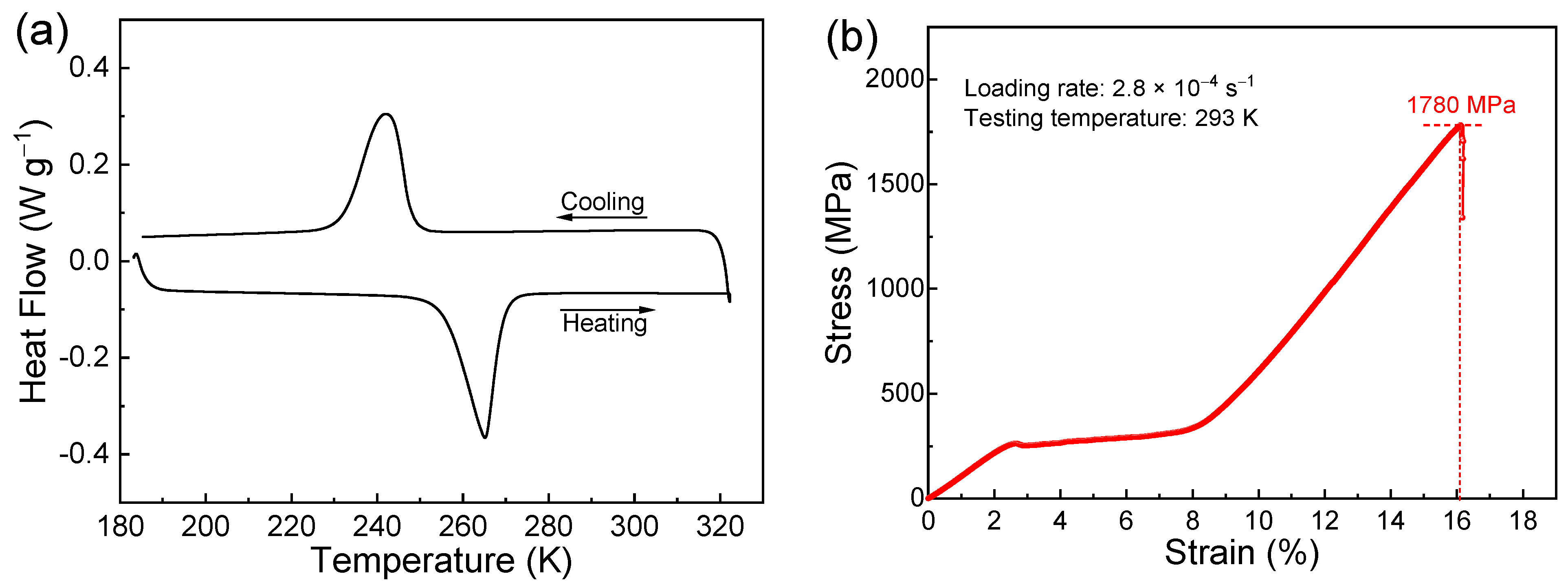
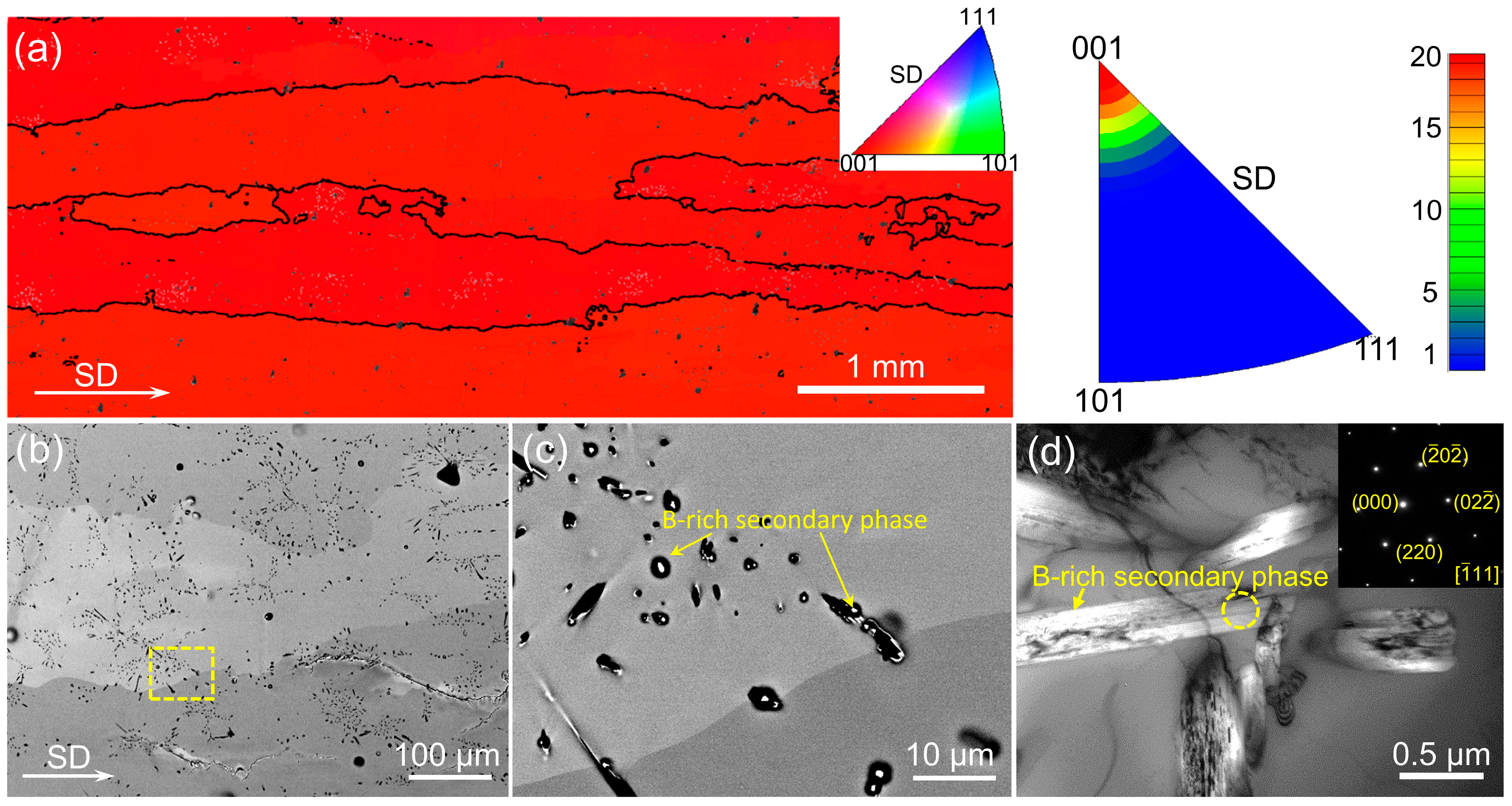
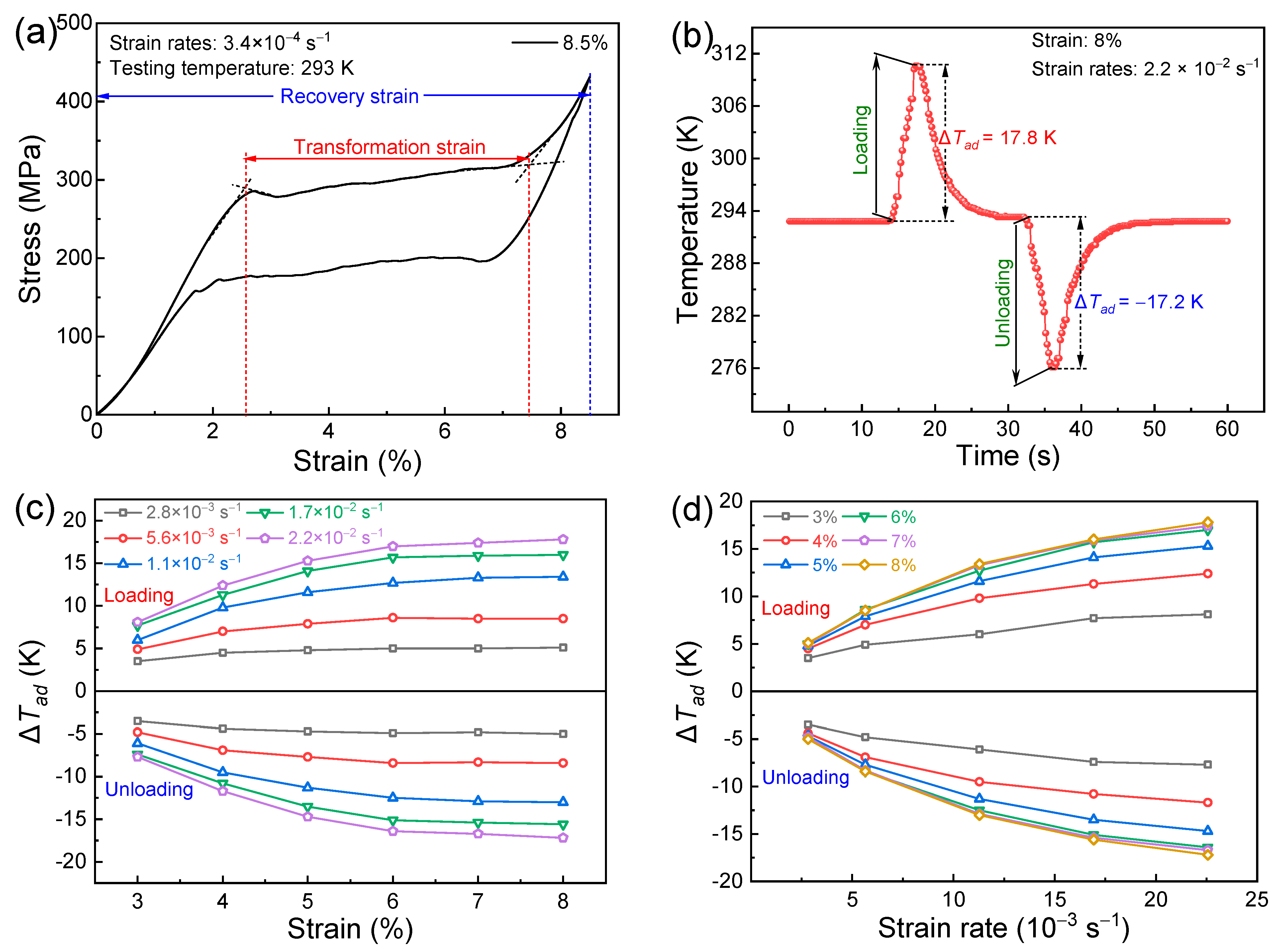
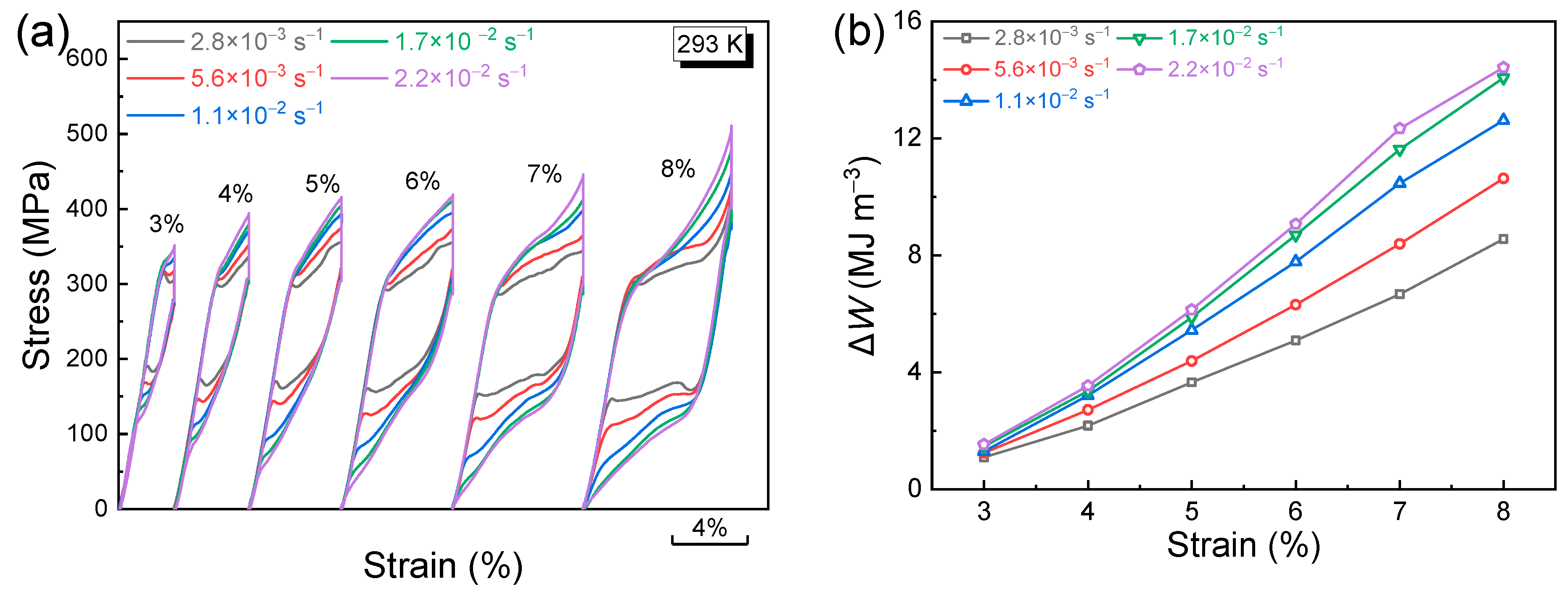

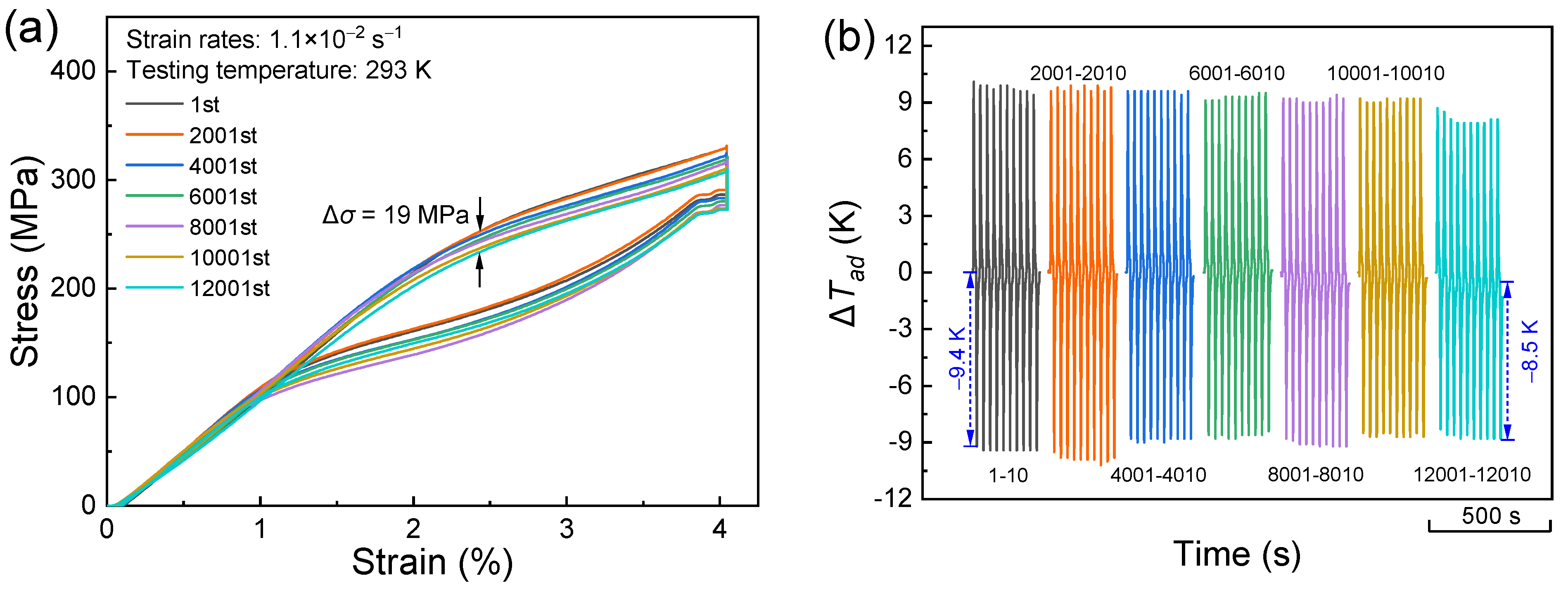
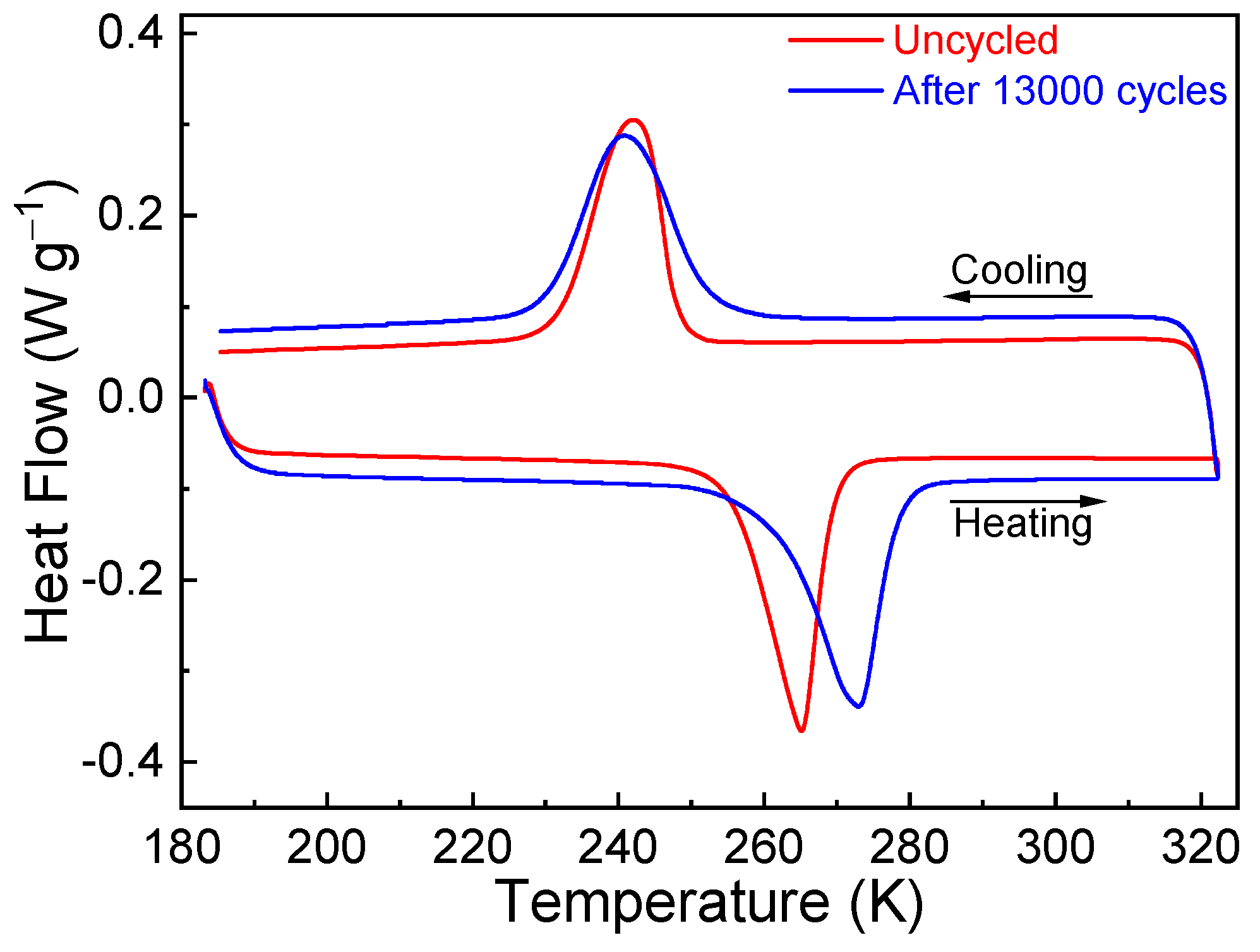

| Alloy | Sample Status | Ttest (K) | |ΔTad| (K) | σmax (MPa) | Strain Rate (s−1) | Ref. |
|---|---|---|---|---|---|---|
| (Ni50Mn31Ti19)99B1 | Polycrystal (textured) | 303 | 27.2 | 412 | 3.0 × 10−1 | This work |
| Ni50Mn31.75Ti18.25 | Polycrystal (textured) | 293 | 20.4 | 913 | 2.0 | [14] |
| Ni50Mn35Ti15 | Polycrystal (untextured) | 293 | 4.5 | 450 | 2.8 × 10−2 | [19] |
| Ni50Mn31.6Ti18.4 | Single crystal | 293 | 29.0 | 830 | 2.0 | [27] |
| Ni37Co9Fe4Mn35Ti15 | Polycrystal (untextured) | 293 | 6.3 | 400 | 1.4 × 10−1 | [57] |
| (Ni50Mn31.5Ti18.5)99.8B0.2 | Polycrystal (untextured) | 308 | 31.5 | 700 | 5.33 | [15] |
| Ni55Mn18Ga27 | Polycrystal (textured) | 300 | 10.7 | 350 | 2.0 × 10−1 | [40] |
| Ni50Mn18.5Ga25Cu6.5 | Polycrystal (textured) | 315 | 8.1 | 100 | 4.2 × 10−2 | [41] |
| Ni50(Mn28.5Cu4.5)(In14Ga3) | Polycrystal (textured) | 293 | 19.0 | 710 | 2.0 | [42] |
| Ni44Mn46Sn10 | Polycrystal (textured) | 320 | 18.0 | 390 | 3.0 × 10−1 | [10] |
| Ni45Mn44Sn11 | Polycrystal (textured) | 298 | 10.0 | 310 | 3.0 × 10−2 | [43] |
| Ni47.5Co4.2Mn37.3Sb12.8 | Polycrystal (textured) | 303 | 8.7 | 400 | 5.0 × 10−2 | [44] |
| Cu71.3Al17.5Mn11.2 | Single crystal | 293 | 11.9 | 120 | 1.4 | [45] |
| Cu59.1Zn27Al13.8Zr0.1 | Single crystal | 343 | 14.2 | 200 | 2.0 × 10−1 | [46] |
| Ni48.9Ti51.1 | Wire | 322 | 21.0 | 900 | 2.0 × 10−1 | [47] |
| Ni50.8Ti49.2 | Polycrystal (textured) | 323 | 17.9 | 913 | 2.0 × 10−1 | [46] |
| Alloy | Sample Status | Number of Cycles | Degradation Rate of ΔTad (K per Cycle) | Ref. |
|---|---|---|---|---|
| (Ni50Mn31Ti19)99B1 | Polycrystal (textured) | 12,000 | 7.5 × 10−5 | This work |
| Ni50Mn30Ti20 | Polycrystal (textured) | 2000 | 5.0 × 10−4 | [39] |
| Ni37Co9Fe4Mn35Ti15 | Polycrystal (untextured) | 1000 | 2.0 × 10−4 | [57] |
| Ni50.4Mn27.3Ga22.3 | Polycrystal (textured) | 250 | 1.2 × 10−3 | [66] |
| Ni50.4Mn27.3Ga22.3 | Polycrystal (textured) | 100 | 2.0 × 10−3 | [12] |
| Ni50Fe19Ga27Co4 | Single crystal | 3000 | 9.3 × 10−4 | [20] |
| Ni54Fe19Ga27 | Single crystal | 100 | 1.0 × 10−3 | [67] |
| Ni54Fe19Ga27 | Polycrystal (untextured) | 100 | 9.0 × 10−3 | [59] |
| Ni53.2Fe19.4Ga27.4 | Polycrystal (untextured) | 480 | 2.3 × 10−3 | [60] |
| Cu71.3Al17.5Mn11.2 | Single crystal | 50 | 4.0 × 10−3 | [45] |
| Cu71Al18Mn11 | Polycrystal (textured) | 275 | 1.5 × 10−3 | [61] |
| Cu71.1Al17.2Mn11.7 | Polycrystal (textured) | 200 | 1.0 × 10−3 | [53] |
| Cu59.1Zn27Al13.8 | Polycrystal (untextured) | 10,000 | 1.4 × 10−4 | [46] |
| Co49Fe3V33Ga15 | Polycrystal (textured) | 200 | 1.5 × 10−3 | [62] |
| Co50V35Ga14Ni1 | Polycrystal (untextured) | 4000 | 8.5 × 10−4 | [63] |
| (Ni42.5Ti50Cu7.5)99Co1 | Polycrystal (textured) | 200 | 2.2 × 10−2 | [64] |
| Ti54.9Ni32.5Cu12.6 | Polycrystal (untextured) | 1502 | 2.0 × 10−4 | [65] |
Disclaimer/Publisher’s Note: The statements, opinions and data contained in all publications are solely those of the individual author(s) and contributor(s) and not of MDPI and/or the editor(s). MDPI and/or the editor(s) disclaim responsibility for any injury to people or property resulting from any ideas, methods, instructions or products referred to in the content. |
© 2024 by the authors. Licensee MDPI, Basel, Switzerland. This article is an open access article distributed under the terms and conditions of the Creative Commons Attribution (CC BY) license (https://creativecommons.org/licenses/by/4.0/).
Share and Cite
Wang, H.; Wang, Y.; Zhang, G.; Li, Z.; Yang, J.; Li, J.; Yang, B.; Yan, H.; Zuo, L. Giant Elastocaloric Effect and Improved Cyclic Stability in a Directionally Solidified (Ni50Mn31Ti19)99B1 Alloy. Materials 2024, 17, 4756. https://doi.org/10.3390/ma17194756
Wang H, Wang Y, Zhang G, Li Z, Yang J, Li J, Yang B, Yan H, Zuo L. Giant Elastocaloric Effect and Improved Cyclic Stability in a Directionally Solidified (Ni50Mn31Ti19)99B1 Alloy. Materials. 2024; 17(19):4756. https://doi.org/10.3390/ma17194756
Chicago/Turabian StyleWang, Honglin, Yueping Wang, Guoyao Zhang, Zongbin Li, Jiajing Yang, Jinwei Li, Bo Yang, Haile Yan, and Liang Zuo. 2024. "Giant Elastocaloric Effect and Improved Cyclic Stability in a Directionally Solidified (Ni50Mn31Ti19)99B1 Alloy" Materials 17, no. 19: 4756. https://doi.org/10.3390/ma17194756









